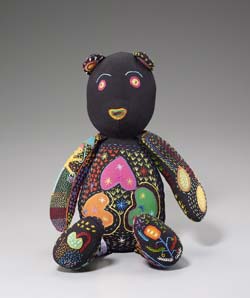
Although bears are not native to Africa, teddy bears have recently appeared on the continent, most notably in South Africa. The stuffed toy bear, first introduced by German and American toy companies in 1903, became an international favorite characterized as a lovable and caring friend that became the guardian of the nursery.
The international movement of creating handmade teddy bears as collectables or soft sculptures reached South Africa in the 1990s. Artists with ties to teddy bear artists in Europe, Asia and the United States work primarily in mohair; the cream and honey colored long mohair is produced locally. Bears, such as the ringed-neck, small rose-colored bear are inspired by the beadwork or designs of the Ndebele peoples.
Other teddy bears have a more serious purpose. While imported commercially made bears are given by a number of charitable organizations to sick children, locally made bears created by workshops and craft cooperatives fund a variety of programs. The embroidered bear shown here is from a Cape Town project that employs 15 women who are HIV/AIDS positive. The name for the project, "The Original Forward Bear," is translated from the Xhosa term for "moving forward."

The Original Forward Bear Workshop
Cape Town, South Africa
Teddy bear
c. 2008
Cotton cloth, embroidery floss
Private collection |

Megan Chamberlain
Cape Town, South Africa
c. 1998
South African mohair, sude cloth, glass
Private collection
Lisa Durbach
Pretoria, South Africa
Teddy bear: Beetroot Batrudi, 1/25
c. 2003
Hand-dyed mohair, onyx beads
Private collection
|
|